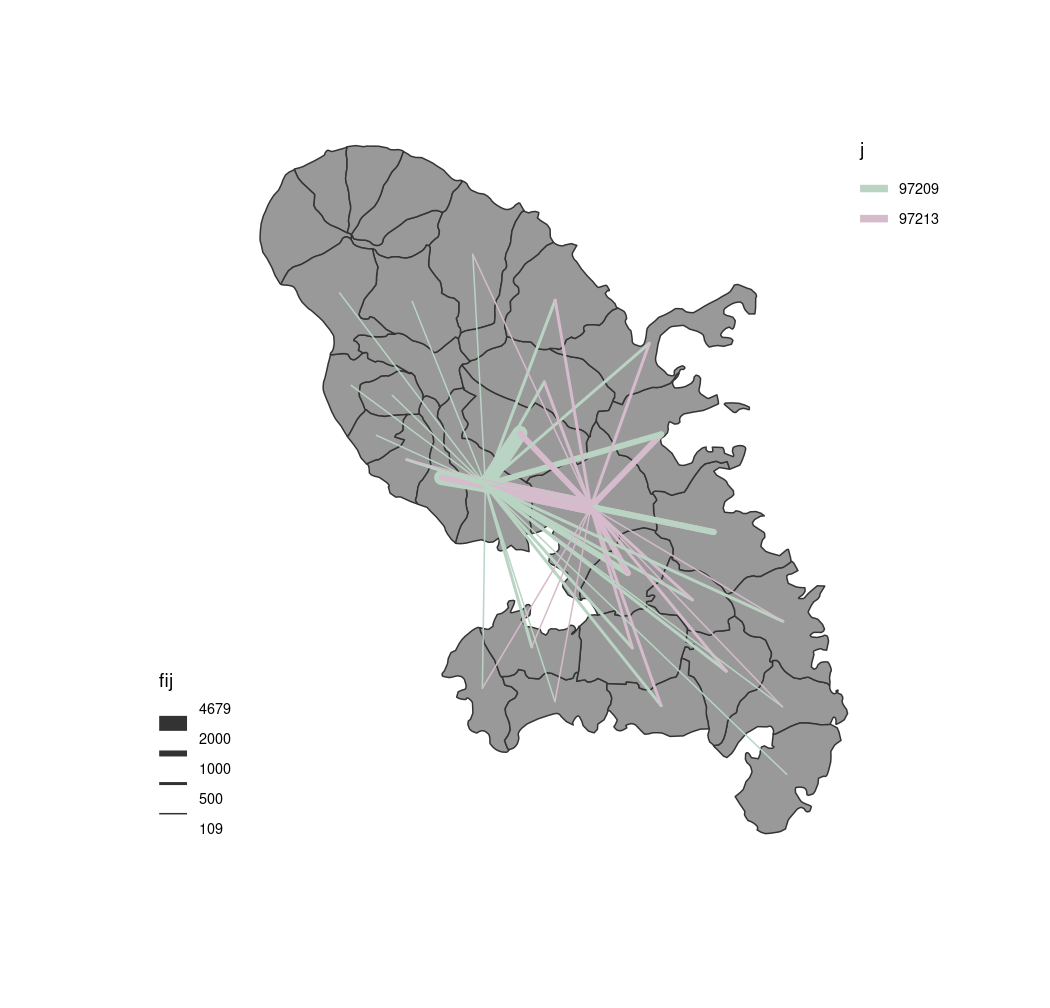Plot a layer of colored and graduated links. Links are plotted according to discrete classes of widths. Colors depend on a discrete variable of categories.
gradLinkTypoLayer(
x,
df,
xid = NULL,
dfid = NULL,
var,
breaks = getBreaks(v = df[, var], nclass = 4, method = "quantile"),
lwd = c(1, 2, 4, 6),
var2,
col = NULL,
colNA = "white",
legend.title.cex = 0.8,
legend.values.cex = 0.6,
legend.values.rnd = 0,
legend.var.pos = "bottomleft",
legend.var.title.txt = var,
legend.var.frame = FALSE,
legend.var2.pos = "topright",
legend.var2.title.txt = var2,
legend.var2.values.order = NULL,
legend.var2.nodata = "no data",
legend.var2.frame = FALSE,
add = TRUE
)Arguments
- x
an sf object, a simple feature collection.
- df
a data frame that contains identifiers of starting and ending points and variables.
- xid
names of the identifier variables in x, character vector of length 2, default to the 2 first columns. (optional)
- dfid
names of the identifier variables in df, character vector of length 2, default to the two first columns. (optional)
- var
name of the variable used to plot the links widths.
- breaks
break values in sorted order to indicate the intervals for assigning the lines widths.
- lwd
vector of widths (classes of widths).
- var2
name of the variable used to plot the links colors.
- col
color of the links.
- colNA
no data color.
- legend.title.cex
size of the legend title.
- legend.values.cex
size of the values in the legend.
- legend.values.rnd
number of decimal places of the values in the legend.
- legend.var.pos
position of the legend, one of "topleft", "top", "topright", "right", "bottomright", "bottom", "bottomleft", "left" or a vector of two coordinates in map units (c(x, y)).
- legend.var.title.txt
title of the legend (numeric data).
- legend.var.frame
whether to add a frame to the legend (TRUE) or not (FALSE).
- legend.var2.pos
position of the legend, one of "topleft", "top", "topright", "right", "bottomright", "bottom", "bottomleft", "left" or a vector of two coordinates in map units (c(x, y)).
- legend.var2.title.txt
title of the legend (factor data).
- legend.var2.values.order
values order in the legend, a character vector that matches var modalities. Colors will be affected following this order.
- legend.var2.nodata
text for "no data" values
- legend.var2.frame
whether to add a frame to the legend (TRUE) or not (FALSE).
- add
whether to add the layer to an existing plot (TRUE) or not (FALSE).
Note
Unlike most of cartography functions, identifiers variables are mandatory.
See also
Examples
library(sf)
mtq <- st_read(system.file("gpkg/mtq.gpkg", package="cartography"))
#> Reading layer `mtq' from data source
#> `/tmp/RtmpmpfIrO/temp_libpath18ee15f22a9e/cartography/gpkg/mtq.gpkg'
#> using driver `GPKG'
#> Simple feature collection with 34 features and 7 fields
#> Geometry type: MULTIPOLYGON
#> Dimension: XY
#> Bounding box: xmin: 690574 ymin: 1592536 xmax: 735940.2 ymax: 1645660
#> Projected CRS: WGS 84 / UTM zone 20N
mob <- read.csv(system.file("csv/mob.csv", package="cartography"))
# Create a link layer - work mobilities to Fort-de-France (97209) and
# Le Lamentin (97213)
mob.sf <- getLinkLayer(x = mtq, df = mob[mob$j %in% c(97209, 97213),],
dfid = c("i", "j"))
# Plot the links - Work mobility
plot(st_geometry(mtq), col = "grey60",border = "grey20")
gradLinkTypoLayer(x = mob.sf, df = mob,
var = "fij",
breaks = c(109,500,1000,2000,4679),
lwd = c(1,2,4,10),
var2='j', add = TRUE)
